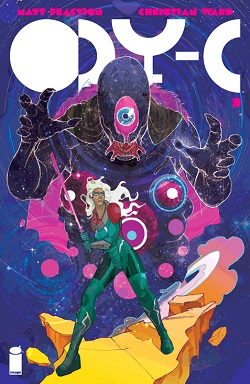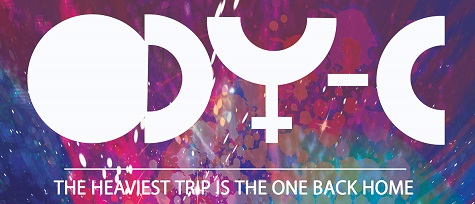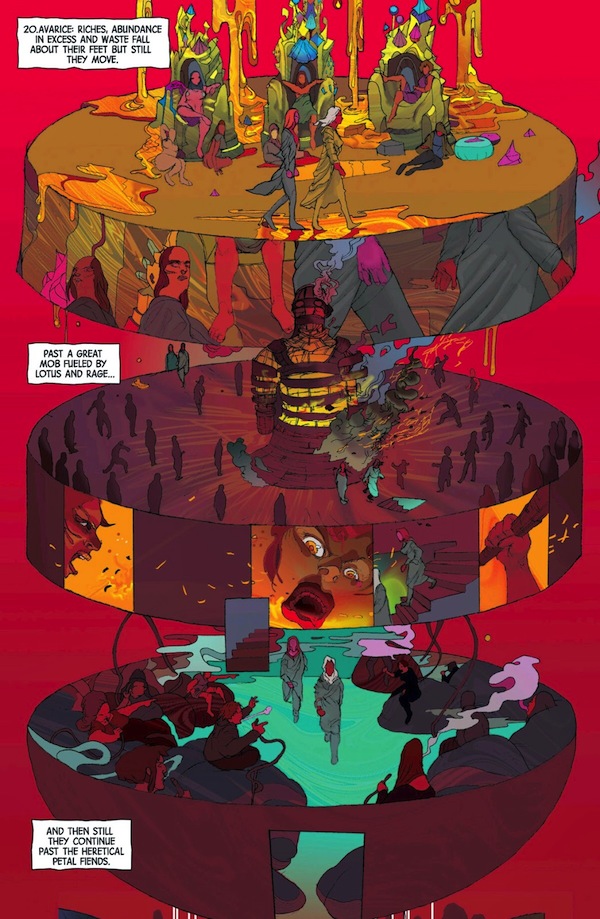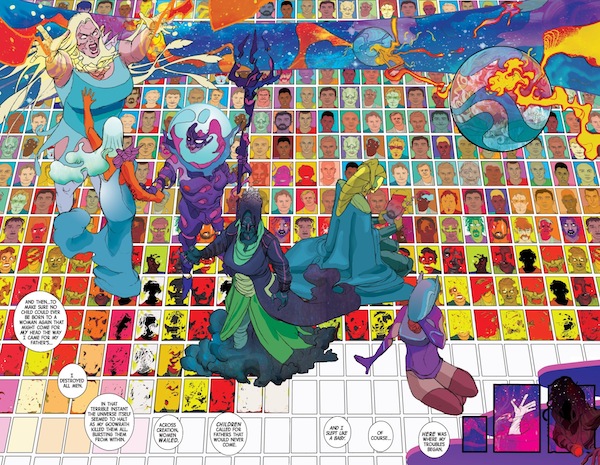People have been retelling, reimagining, and recontextualizing the Odyssey ever since Homer figured out the easiest way to memorize long stanzas of poetry was through dactylic hexameter. James Joyce’s Ulysses is an obvious homage, as is the Coen Brothers’ O Brother, Where Art Thou? and the French-Japanese animated series Ulysses 31. Twelfth-century Irish writers tweaked the Greek classic into Merugud Uilix maicc Leirtis, Dante dabbled in Odysseus fanfic in his Inferno, and the great and glorious Margaret Atwood let Penelope tell her side of the story in The Penelopiad.
Now with ODY-C, it’s Matt Fraction and Christian Ward’s turn, and trust me, it’s the interpretation you’ve been waiting for.
Origin Story
 After a bloody hundred-year war against Troiia, the Achaean conqueror queens finally pummel their enemies into submission and take He, one of the last males in the universe, captive. Millennia before, the gods feared their own children overthrowing them as they did the Titans, so Zeus destroyed all males. Titan Promethene, filled with god-thought and the hubris to think she could best the gods, created sebex, a third sex that could mate with human women but not produce males. Odyssia, Queen of Ithicaa and pilot of the Promethene-blessed spaceship ODY-C, has little time for gods or their machinations, but unfortunately for her, they have all the time in the world. She slighted them once, and the gods are petty, tyrannical, and vengeful enough to pull her off course and send her and her crew tumbling through the distant reaches of endless space. Getting home will be as much of a trial as surviving the war.
After a bloody hundred-year war against Troiia, the Achaean conqueror queens finally pummel their enemies into submission and take He, one of the last males in the universe, captive. Millennia before, the gods feared their own children overthrowing them as they did the Titans, so Zeus destroyed all males. Titan Promethene, filled with god-thought and the hubris to think she could best the gods, created sebex, a third sex that could mate with human women but not produce males. Odyssia, Queen of Ithicaa and pilot of the Promethene-blessed spaceship ODY-C, has little time for gods or their machinations, but unfortunately for her, they have all the time in the world. She slighted them once, and the gods are petty, tyrannical, and vengeful enough to pull her off course and send her and her crew tumbling through the distant reaches of endless space. Getting home will be as much of a trial as surviving the war.
ODY-C was created by Matt Fraction (Hawkeye, Casanova, half of House DeFraction) and Christian Ward (Olympus, Infinite Vacation, no not that Christian Ward). It is published through Image Comics. The first issue was released in November 2014, and #5 is scheduled for May 6. The 5-page prologue (the end of the Trojan War) is available for free online. Those looking for a bit of an academic primer in Homeric poetry will be jazzed about the essay in the back of #4 by classicist/blogger Dani Colman.

To Pull or Not to Pull
The Odyssey is a sprawling tale that starts during the decade-long Trojan War in the Iliad and spans another decade as he journeys home. Along the way he is enticed by seductive women, pushed off course by magical bags of wind, cursed by enchanted food, shipwrecked, and nearly killed over and over again. Even when he finally makes it back to Ithaca he must defend his crown, son, and wife from treacherous suitors. And if you thought it couldn’t get anymore epic, then you haven’t read ODY-C. ODY-C is an epic of epic epicness. It is a futuristic space opera fantasy full of gods, humans, monsters, and mythical creatures set to the music of a gender and queerbent The Odyssey. It’s as much Barbarella as it is Homer. The lyrics and tempo may be different, but the tune is still recognizable.
Fraction came up with ODY-C as an attempt to give his daughter, Tallulah Louise, a story about a female adventurer: “There’s this fallacy in American comics anyway that women don’t have power fantasies or don’t enjoy adventure stories.” ODY-C proves those asshats so very wrong. The series is too adult for his daughter, but when she’s old enough she’ll read it and feel a kinship with the characters. Many men not named Matt Fraction write women as “woman,” forgetting that “woman,” like “mother,” “Strong Female Character,” “virgin,” and “whore,” aren’t personality types but lazy tropes that don’t actually describe who a person is.
The theme of motherhood and the many variations and interpretations of it run through nearly every character. Zeus kills as many of her children as she saves with no regret for the lives she takes and little investment in those she spares. Sebex Ero is desperate for a child Odyssia refuses to give her because she knows it is the only thing that might tempt her lover to leave her wife. Odyssia has a child of her own and will fight heaven and hell to get back to her family. Odyssia is a mother, but that is only one facet of her life. Motherhood doesn’t define who she is as a person, but her personality explains what kind of mother she is.
Odyssia is a warrior of cunning intelligence, but the meaning of her namesake is far darker. There’s a ton of debate about what Odysseus actually means—seriously, do a quick scan of JSTOR on the topic and call me in a few years when you dig yourself out of the pile—but none of them are positive traits. Odysseus has been said to mean “trouble,” “hate,” “wrath,” “bringer of pain,” “God-hated,” “fated for trouble,” “to be wroth against,” “to bewail or lament,” and so on. Odyssia delivers pain, trouble, hate, and lamentations, and suffers from same. She is called Trickster and Thief just as Odysseus was (he was the grandson of the notorious thief Autolycus and grandson of Hermes, god of borders, athleticism, feasts, animal husbandry, trade, divination, thieves and trickery, travelers, wit and wiles, and protector of the home, aspects which feature heavily in The Odyssey), and certainly lives up to the name, depending on whose perspective she’s viewed through. She sees herself as a hero and champion, but once the bloodlust wears off and the swords are put to rest, the realities of the atrocities she’s inflicted wear at her soul. She may be a semi-divine being, but she’s also a mother and wife who just wants to go home.
Issue #1 sets the tone of the series with an 8-page spread, one side a massive splash of the warrior queens marching over their conquered lands, the other a map and timeline of the events leading up to the Troiian War. The reason it’s only 8 pages? Because Fraction and Ward were told that their originally-planned 10 pages would break the printing presses. It’s crushingly detailed—and helpfully color coded!—and Homer nerds will especially love playing spot the difference. The series as a whole is largely free of dialogue (the gods speak frequently, the humans rarely), and even the prose, what Fraction half-jokingly calls “dummy hexameter,” is sparse. But each word, each phrase is a deliberate powerhouse. It feels less like reading and more like listening to a poet telling a story. It’s like sitting around a campfire, smoking a bunch of peyote, closing your eyes, and immersing yourself in the imagined world the storyteller is crafting.
Fraction’s laconic script is contrasted by the symphony of color in Ward’s artwork. It is visceral, vicious, vivacious, vivid. There is no typical page in ODY-C, and no 2 pages look the same. He uses panel boxes sparingly, and mostly to prove you can do so much more than the usual 9-panel structure. Each page, each panel, each character, each bit of mise-en-scene is a masterpiece in and of itself. The characters are impressive in their uniqueness. Ward’s gods are…I don’t even know how to describe them. They are as groundbreaking as Neil Gaiman’s Endless. He reworks Poseidon into a god that is literally the universe. Athena is a bearded man with a mechanical owl, Dionysus a goddess made of blood and wine, and the almighty mother-father Zeus is nothing if not reminiscent of the “fat ladies” of neolithic Malta. You know that moment when you put on a pair of really good headphones and suddenly that song you’ve heard a million times becomes this cacophony of notes and sounds and you can feel them interacting with and building upon one another? That’s what the art is like. Dazzling, sublime, sumptuous, opulent…there just aren’t words for how incredible Ward’s art is.
A quick moment of praise for Chris Eliopoulos. I don’t know much about lettering, but even I noticed a stark difference with his work on ODY-C and the usual lettering. There are few speech bubbles and inconsistent text placement. The text flows and shifts around the page to fit the cadence of Fraction’s prose and the poetry of Ward’s art. The thing about dactylic hexameter is that it’s more rhythm than rhyme. Colman points out in her essay that post-Homeric poets used “combinations of dactyls [a long syllable followed by two short ones] and spondees [two long syllables] to imitate the galloping of horses or the earthshaking footsteps of the Titans.” Eliopoulos mimics that tradition by staggering text boxes across Ward’s landscape. It almost gives Fraction’s script a staccato-y feel, like a crunchiness. And by using colors to indicate which human is speaking rather than bubbles, it keeps consistent the feeling of hearing a story rather than being a fly on the wall of a live event.
ODY-C is a graphic novel set to Homeric poetry and visualized in a psychedelic dreamscape. It is gorgeous to look at and gorgeous to read. Half the experience of series comes from the feelings the story, art, and text evoke, dependently and independently of each other. I know it’s cliché to say “there’s never been anything like it,” but holy Hera, there’s never been anything like ODY-C.
Alex Brown is an archivist, research librarian, writer, geeknerdloserweirdo, and all-around pop culture obsessive who watches entirely too much TV. Keep up with her every move on Twitter and Instagram, or get lost in the rabbit warren of ships and fandoms on her Tumblr.













